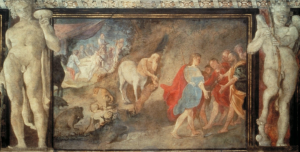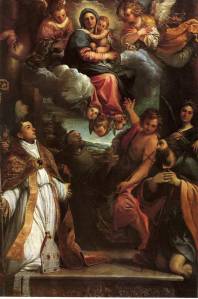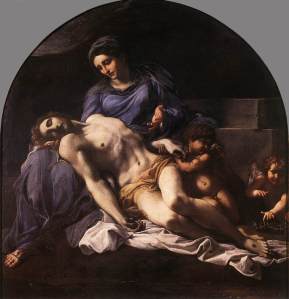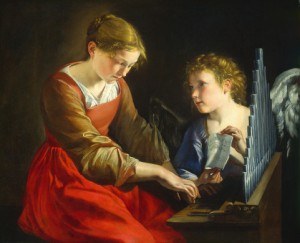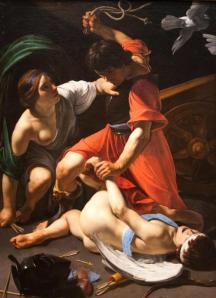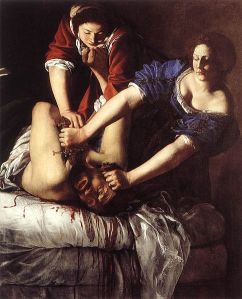The Carracci
The Carracci Family, Story of Jason, Palazzo Fava, 1583-1584, Early Baroque, patron: Fava family, fresco, Palazzo Fava, Bologna
The Carracci family’s collaborative project of the Palazzo Fava represents the pursuit of illusionism, leading to the Baroque principle of truth to nature. The Palazzo Fava in Bologna was undertaken by the Carracci family, consisting of Ludovico, Agostino, and Annibale, and illustrating the unity and singularity in their styles during the early years of the family’s career. The monumental frieze decoration of several rooms in the Palazzo Fava, including the Story of Jason, consisted of eighteen narrative scenes in a cycle, connected in the illusionistic treatment of framing elements. Many early Baroque artists, like the Carracci family, wanted to adopt the qualities associated with Renaissance masters, such as Michelangelo and Raphael, but along with directly quoting specific figures, artists utilized the masters’ attitudes toward representation. The use of the fictive framing system, with a focus upon illusionism, derives from Michelangelo. The Carracci employed the style of quadro riportato, in which paintings are illusionistically placed elsewhere. The illusionistic system of stone figures framing scenes also derived from Michelangelo’s work at the Sistine Chapel, as the viewer looks up toward the depicted figures, as if physical statues. Michelangelo’s technique of ignudi, figures that appear life-like and used by the Carracci, represented Baroque artists’ concern with the viewer and space, as the life-like figures would remain in the world of the viewer, while representations in the realm of painting. The left sculptural figure in the Story of Jason detail is a reference to Michelangelo’s Bacchus, a modern work replicating the antique, illustrating how the Carracci were aware of work outside of Bologna. According to Giovanni Agucchi, the Carracci became a representation of the classical style of selective nature, however, the Carracci’s aim was to combine colore and disegno. With this combination, the Carracci’s goal was to achieve verisimilitude, truth to nature, echoed in the focus upon illusionism in the decorations of the Palazzo Fava. The pursuit of verisimilitude also referenced the philosophical belief of a higher reality, il vero, as by representing nature, one could reach a higher Truth, a notion that separates the Carracci from the naturalism of Caravaggio. As seen with the decoration at the Palazzo Fava, the Carracci formulated compositions through the manipulation of color and light to maintain balance. The development of illusionism was accompanied with the Carracci’s construction of classical compositions, as seen with the frieze decoration. The Story of Jason scene is organized in planes, since during the Baroque there were new scientific ideas about space and time. The planes are united through the composition, but through a diagonal device to create balance, along with an atmospheric perspective to establish a unity. The figures going back into space, along with the use of sculptural figures, emphasized the Carracci aim of developing illusionism, a Baroque approach to naturalism.
Harris, Ann Sutherland. Seventeenth-Century Art & Architecture, 2nd ed. Upper Saddle River, NJ: Pearson Education, Inc. 2008.
Ludovico Carracci, Vision of St. Francis, 1583-86, Early Baroque, oil on canvas, 41″ x 40,” Rijksmuseum, Amsterdam
Ludovico Carracci’s Vision of St. Francis illustrates the development of depicting nature. Ludovico in the work represents an interest in an affective piety, such as the relationship with St. Francis and the Child, similar to the emotional resonance achieved by Barrocci’s figures. St. Francis and the Child serve as the axis of the composition, which then continues into the distance through the use of diagonals, a technique of the Carracci. In the scene, Ludovico attempts to balance the depiction of reality, or nature, with the mystical vision. The Virgin is surrounded by clouds and light, also the only element in the painting depicted with primary color, while reality, St. Francis, is depicted in monochrome tones. Ludovico unites the disegno of diagonals, while also utilizing colore to represent a vision more real than reality. He observes nature to give form to humanity and spiritual representation, ultimately achieving verisimilitude through the combination of disegno and colore (Grove DOA). Ludovico attempts to achieve a method of representing the spiritual and symbolic level through natural means, a process many Baroque artists shared. The naturalism of the religious scenes related to the Counter-Reformation, focusing upon works that displays truth to common experience and inspire the faithful (Grove DOA). Ludovico’s work continues the Baroque characteristic of depicting the spiritual for a Counter-Reformation audience.
Van Tuyll van Serooskerken, C., et al. “Carracci.” Grove Art Online. Oxford Art Online. Oxford University Press. http://www.oxfordartonline.com/subscriber/article/grove/art/T014340. 19 February 2013.
Agostino Carracci, Last Communion of St. Jerome, c. 1590s, Early Baroque, patron: Carthusian monastery, Bologna, oil on canvas, 12′ 4″ x 7′ 4,” Pinacoteca Nazionale, Bologna
Agostino Carracci’s Last Communion of St. Jerome portrays the Baroque focus upon earthly and heavenly realms to communicate Counter-Reformation principles. The work was part of the renovation and decoration of Certosa di San Girolamo outside of Bologna. The painting illustrates the decrees coming from the Council of Trent, concerned with defending the main tenets of the Church and rituals. The principles communicated by the work related to Cardinal Gabriele Paleotti, in Bologna, who professed attacks on the decorum of images, providing guidelines after the Council of Trent to decree what was proper in sacred settings, while promoting clarity of the subject for a didactic role of images. Agostino represents St. Jerome taking the sacrament, in the aesthetic saint’s body, while depicted among symbol connoting the saint, such as the meditation skull and his lion. Monks hold some of the elements of the office of the sacrament, relating to the didactic tool of painting during the Counter-Reformation since the apocryphal legend of St. Jerome recounts the saint receiving his last communion on his knees to represent his humility before Christ (Harris, 19). The frieze of figures in the composition includes a monumental, architectural framework, with a landscape view beyond (Harris, 19). The putti represent a connection between the earthly and heavenly realm, observed by monks on the left, who consider the location of the soul of the saint. Similar to many Baroque artists, Agostino was interested in creating a bridge between the earthly and heavenly realms to inspire the faithful. The development of new monumental altarpieces was completed through a series of preparatory processes, contributing to the strong sense of design in Carracci compositions. Ludovico’s work, also representing his observation of nature to achieve a realistic representation, communicates the Baroque aim of involving coextensive spaces for the viewer, such as the heavenly and earthly realms.
Harris, Ann Sutherland. Seventeenth-Century Art & Architecture, 2nd ed. Upper Saddle River, NJ: Pearson Education, Inc. 2008.
Van Tuyll van Serooskerken, C., et al. “Carracci.” Grove Art Online. Oxford Art Online. Oxford University Press. http://www.oxfordartonline.com/subscriber/article/grove/art/T014340. 19 February 2013.
Annibale Carracci, San Ludovico Altarpiece, c. 1588, Early Baroque, oil on canvas, Pinacoteca Nazionale, Bologna
Annibale Carracci’s San Ludovico Altarpiece represents the continuing influence of Renaissance masters and the Counter-Reformation. The composition suggests the study of Titian and Raphael, especially after Annibale’s work changed quickly after traveling to Venice. Annibale is able to use a glazing technique, in addition to a strong understructure that relates to disegno, and glowing layers of color, emphasizing again the combination of disegno and colore emphasized by the Carracci. The composition continues the Baroque aim of creating a connection between different realms, but for Caravaggio, between the figure and viewer. The Carracci were interested in unifying realms, between earthly and heavenly realms of painting. The unification of realms related to Counter-Reformation doctrines of inspiring the faithful through a straightforward manner of painting. The figures, predominantly in the frontal plane, are framed by architecture. Annibale continues the technique of using diagonals, as seen with the gestures of figures, varying in direction. The indexical figures become part of the rhetorical effort on the part of the composition, such the main figures, St. Ludovico, bishop saint, and the Virgin and Child on the clouds. Annibale’s preparatory studies for the altarpiece reflects the arched monumental frame created by the architecture, also mirroring the frame created by the altarpiece with the lunette top. Annibale emphasize illusion, therefore when the viewer looked at the altarpiece through the archway, there was continuity between the actual and the represented, stressing the heavenly and earthly realms, while making a connection to the realm of the viewer with the gesture of St. John the Baptist. Annibale through his figures and compositional frames aims to connect the viewer to the spiritual scene, a Counter-Reformation principle.
Annibale Carracci, Pietà, c. 1599-1600, Early Baroque, patron: possibly commissioned by Cardinal Odoardo Farnese, oil on canvas, 5′ 1 3/8″ x 4′ 10 5/8,” National Museum of Capodimonte, Naples
Annibale Carracci’s Pietà continued his classicism with the achieved sculptural effect. The work was possibly made for a chapel in the Palazzo Farnese at Caprarola. Christ is draped over Mary’s lap, as she gestures toward the viewer to direct attention to the event (Harris, 31). The sculptural effect created by the figures, references Michelangelo, with a new classicism that returns to Renaissance masters. Annibale was admired for the horizontal compositional form, and the expressive quality of the interaction between the figures, such as his ability to give moving and emotive qualities through subtle gestures. Annibale continues naturalism based on the direct observation of nature, to give human form to classical or sculptural figures. He approaches the religious scene with a reductive nature to the environment, along with an atmospheric quality relating to the influence of Correggio. The tomb slab, an element seen in Caravaggio’s work, points toward the viewer and develops a connection. Carracci also makes playful allusion to the Passion of the Christ, seen with the angels, as one holds the hand of Christ, turning toward the other angel who pricks his fingers on the thorns, looking at the viewer. The work reflects the continuation of classicism with the use of sculptural figures, while representing the emotive qualities achieved by Baroque artists.
Harris, Ann Sutherland. Seventeenth-Century Art & Architecture, 2nd ed. Upper Saddle River, NJ: Pearson Education, Inc. 2008.
The “Caravaggisti”
Orazio Gentileschi, St. Cecilia Altarpiece, n.d., Early Baroque, oil on canvas, Pinacoteca di Brera, Milan
Orazio Gentileschi’s (1563-1639) St. Cecilia Altarpiece illustrates the influence of Caravaggio’s techniques upon Baroque artists, such as tenebrism. Orazio is included in the first generation of contemporaries influenced by Caravaggio, working in Rome during the same period. In Rome, public works of Caravaggio were available to artists, leading to many, like Orazio, using multi-figure compositions, full-scale, and tenebrist atmospheric treatment. Orazio as an early follower of Caravaggio took up his style to stay current. In St. Cecilia Altarpiece, Orazio incorporates tenebrist qualities, as seen with the dramatic lighting derived from Caravaggio. However, compared to the vague, dark backgrounds of Caravaggio, Orazio places the religious scene in a specific setting. Orazio adopted various Caravaggio techniques of lighting and figural composition, but he maintained his use of color. The altarpiece utilizes elements of naturalism, such as the direct observation of nature in the treatment of the angel’s wings to create a straightforward depiction of a religious scene for the faithful. Orazio represents one of the various “Caravaggisti” adopting the techniques of Caravaggio, combined with their own personal elements. The dramatic lighting in the scene, such as the light highlighting the arm of St. Cecilia, derives from religious scenes of Caravaggio, however, Orazio maintains his graceful treatment of form and drapery, achieving clarity in his use of color.
Harris, Ann Sutherland. Seventeenth-Century Art & Architecture, 2nd ed. Upper Saddle River, NJ: Pearson Education, Inc. 2008.
Harris, Ann Sutherland and, Judith W. Mann. “Gentileschi.” Grove Art Online. Oxford Art Online. Oxford University Press. http://www.oxfordartonline.com.libproxy.temple.edu/subscriber/article/grove/art/T031374pg1. 26 February 2013.
Orazio Gentileschi, St. Cecilia and the Angel, c. 1617/1618 and c. 1621/1627, Early Baroque, oil on canvas, 34 7/16″ x 42 1/2,” National Gallery of Art, Washington D.C.
Orazio Gentileschi’s St. Cecilia and the Angel illustrates the continuing influence of Caravaggio upon Roman artists, specifically with the use of light to represent the Baroque attention to drama. The work involves the use of chiaroscuro to focus upon the religious figures set against a Caravaggio nondescript background. The foreshortening of the instrument, accompanied with the lighting, creates a dramatic impact. The drama, emphasized by Orazio with his use of Caravaggio techniques, derives from the Baroque naturalism of light, such as a divine illumination spurred by the angel in the scene. The naturalism of Caravaggio continues with Orazio, such as the intense observation of life to achieve the dramatic, contemplative moment (Grove DOA). Instead of the emotional, Orazio emphasizes the rational with the use of color and treatment of form, shifting from the controversial quality of Caravaggio’s works. The Baroque naturalism to achieve drama is attained by Orazio’s adaptation of Caravaggio techniques.
Harris, Ann Sutherland and, Judith W. Mann. “Gentileschi.” Grove Art Online. Oxford Art Online. Oxford University Press. http://www.oxfordartonline.com.libproxy.temple.edu/subscriber/article/grove/art/T031374pg1. 26 February 2013.
Martin, John Rupert. Baroque. New York: Harper & Row. 1977.
Bartolomeo Manfredi, Bacchus and a Drinker, 1600-10, Early Baroque, oil on canvas, 52″ x 38,” Galleria Nazionale d’Arte Antica, Rome
Bartolomeo Manfredi’s (1582-1622) Bacchus and a Drinker relates to the influence of Caravaggio’s early works upon the Caravaggisti. Manfredi also takes up the style of Caravaggio, possibly his closest imitator in Rome. Manfredi’s Bacchus and a Drinker adopts the use of ordinary-looking models to achieve a direct naturalism. The use of chiaroscuro and foreshortening in the scene echoes Caravaggio’s work, as the dramatic lighting intensifies the moment, while the foreshortening begins to include the viewer into the coextensive space. The raking light and dark background wall are direct quotes from Caravaggio works, representing Manfredi’s knowledge of his techniques (Grove DOA). The nondescript background allows the viewer to focus primarily upon the genre scene of Bacchus, represented as a heavy drinker with the red nose. As a Caravaggio follower, Manfredi would reinterpret Caravaggio’s subjects, while using his naturalism and dramatic chiaroscuro. Northern followers of Caravaggio would offer a coarser treatment of street subjects which Caravaggio had made popular, leading to an expansion in this genre, as seen with the figure accompanying Bacchus. Manfredi focused upon choosing Caravaggio’s early period subjects, such as allegories, mythologies, and genre scenes (Grove DOA). Manfredi utilized techniques of light and choice of subject matter popularized by Caravaggio.
Chvostai, John J. “Manfredi, Bartolomeo.” Grove Art Online. Oxford Art Online. Oxford University Press. http://www.oxfordartonline.com.libproxy.temple.edu/subscriber/article/grove/art/T053775. 26 February 2013.
Bartolomeo Manfredi, Mars Punishes Love, 1613, Early Baroque, oil on canvas, 69″ x 51 3/8,” The Art Institute of Chicago
Bartolomeo Manfredi’s Mars Punishes Love represents the combination of Caravaggio traits from various periods to create a dramatic moment. The work portrays an allegorical subject matter, specifically classical, a topic depicted by Caravaggio in his early period (Grove DOA). However, Manfredi blends the early subject matter with the style of Caravaggio’s later period, a characteristic often seen with followers. The genre subject becomes combined with tenebrism, as seen with the classical scene of the dramatic illumination upon the figures against a nondescript background. The strong chiaroscuro creates sharply defined forms, referencing Manfredi’s abilities to master Caravaggio’s technique (Grove DOA). Manfredi illustrates the dramatic moment of Mars punishing Love, further accentuated by the raking light across Mars and the illumination of Love. Manfredi also adopts the Caravaggio technique of placing elements against the picture plane, pushing the realm of painting closer to the viewer. The use of Caravaggio techniques ultimately reinforces the Baroque naturalism to create the dramatic moment.
Chvostai, John J. “Manfredi, Bartolomeo.” Grove Art Online. Oxford Art Online. Oxford University Press. http://www.oxfordartonline.com.libproxy.temple.edu/subscriber/article/grove/art/T053775. 26 February 2013.
Artemisia Gentileschi, Judith Slaying Holofernes, 1611-1612, Early Baroque, oil on canvas, 63″ x 50,” Museo Nazionale di Capodimonte, Naples
Artemisia Gentileschi’s (1593-1654) Judith Slaying Holofernes uses dramatic lighting to illuminate the decisive moment of the scene, a technique of Caravaggio. Artemisia, the daughter of Orazio Gentileschi, assisted her father in the studio, leading to her development as a female artist (Harris, 52). The work, one of two pictures depicting Judith decapitating Holofernes, references Caravaggio’s own painting portraying the Biblical scene (Harris, 53). The Biblical story was popular during the early seventeenth century, as early Baroque artists referenced war and martyrdom (Grove DOA). Artemisia’s choice of subject also possibly references a form of “visual revenge” after her rape in Rome (Grove DOA). Judith and her servant overpower and murder the Assyrian general, Holofernes. Artemisia emphasizes the naturalism of the decapitation, a technique of Caravaggio with the visual realism. She also utilizes Caravaggio’s dark setting for her scene, while still utilizing the color to create a dramatic impact (Harris, 53). The “flashes of light” on the figures in the front plane reinforce the decisive moment of the scene to create a dramatic visual for the viewer (Harris, 53).
Harris, Ann Sutherland. Seventeenth-Century Art & Architecture, 2nd ed. Upper Saddle River, NJ: Pearson Education, Inc. 2008.
Harris, Ann Sutherland and, Judith W. Mann. “Gentileschi.” Grove Art Online. Oxford Art Online. Oxford University Press. http://www.oxfordartonline.com.libproxy.temple.edu/subscriber/article/grove/art/T031374pg1. 26 February 2013.

